Every succulent is a charmer in some way, but a flowering succulent is truly a sight to behold, a beauty to be enjoyed. If you too are interested in flowering succulents like me, let’s find 20+ succulents with pink flowers that flower freely every year, provided they are given a suitable atmosphere and proper care.
20+ Succulent With Pink Flowers
Christmas Cactus
- Height: 12 ” (30 cm) in height and width- 5 inch (13 cm)
- Blooming season: Winters
- Care: Bright, indirect sunlight, Watering only when the top-soil is dry and potting soil rich in organic matter is best for it
The Christmas cactus is a beautiful succulent with hanging green branches, blooms in pink, white, yellow, purple and red flowers that lasts for several weeks generally around Christmas.

Mostly, Christmas cacti bloom in the winter, but it can bloom several times in a year.
Easy to maintain indoor succulent with pink flowers, all they need to thrive in bright, indirect sunlight and some humidity.
Christmas cacti should be kept in a bright place with indirect sunlight. East-facing windows, kitchen and bathrooms are the best places to keep them.
Water a Christmas cactus only when the top inch or 2 of soil is dry. To increase the humidity around the Christmas cactus, place some rocks in the pot saucer and add water just below the rocks so that the pot remains above water. It will add more humidity as the water evaporates.
The ideal day temperature for Christmas cacti is 21°C (70°F) and an evening temperature is 15-18°C( 60-65°F).
Giving your Christmas cactus 6 weeks of extra darkness and lower temperature will encourage blooming.
October Daphne (Sedum Sieboldii)
- Height: 6″ to 12″ tall and 12″ to 15″ wide
- Blooming Season: Early to Mid Fall
- Care: Full sun to partial shade, Watering moderately when the soil is dry and well draining sandy loam soil.
October Daphne is a perennial succulent with rounded, blue-green leaves that produces clusters of star shaped, pink blooms in Early to Mid fall and looks awesome in hanging baskets.
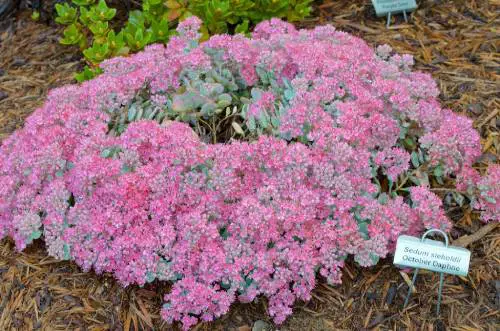
It works well as a succulent ground cover with pink flowers.
In October, Sedum sieboldii’s foliage develops shades of pink, red, orange and yellow.
It is very hardy as it can survive in cold weather even in -20 degrees.
Water October Daphne only when the soil is dry to touch. Avoid over watering as it can kill your succulent.
A well-draining sandy-loam soil mixed with perlite is best to grow this succulent.
October Daphne likes full sun and you can also grow them indoors, but to get the blooms, keep them outdoors in pots or in the rock garden.
Orchid Cactus( Epiphyllum Spp.)
- Height: 2 ft (60 cm) long and about 2 inches (5 cm) wide
- Blooming time: Day bloomers in April to June, night bloomers in Late Summers to Early Fall
- Care: Bright indirect light, water every ten days, potting mix with 3 parts commercial potting soil and 1 part pumice.
Orchid cactus blooms in Spring with big, cup-shaped, pink, red, white, yellow flowers( 4-8 in (10-20 cm) wide) on the ends of long spilling stems. Display them in hanging baskets or in pots and they are very enticing.
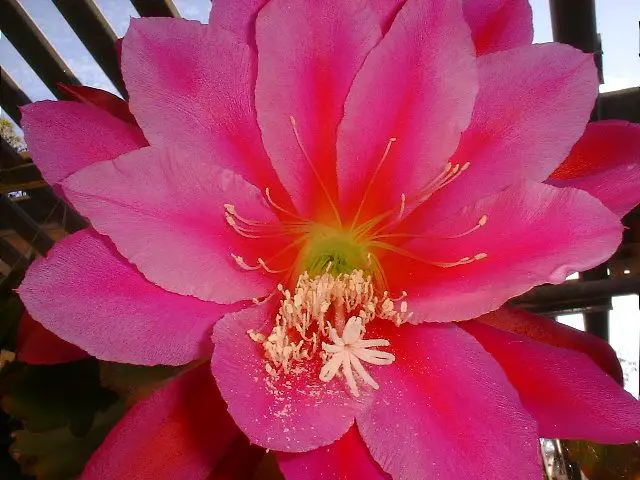
Orchid cactus stems are broad, flat with serrated edges, and can grow up to 60 cm(2 feet) long and about 2 5 cm (2 inches) wide.
This tropical cactus on getting plenty of light will give months of blooms.
A few hours of the full morning sun, but not the full midday sun is best for this plant. In winters, keep your plants in a cool (40 ° F) room. Avoid any lights after daylight hours to prevent delayed flowering for the next year.
Watch for over/under exposure to light.
Sunburned or yellowish wilted growth means exposure of the plant to excess light. Weak leggy growth means the plant is getting insufficient light. Right amount of light gives fresh green growth (light to dark green) with slightly red edges.
A soil mix holding moisture but draining quickly is best for Orchid cacti. Mix three parts potting soil with one part pumice or perlite, or potting soil with half peat moss to one part perlite.
Oscularia Deltoides (Pink Ice Plant)
- Height: 6″ to 1 foot
- Blooming time: Spring and Summer
- Care: 5 to 6 hours of sunlight daily, water moderately when the soil is dry and cactus potting mix with perlite.
Oscularia Deltoides is a low-growing, succulent groundcover with pink flowers that sprawl and spread with time.
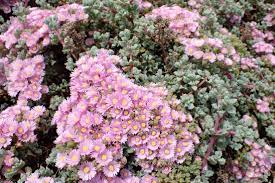
Oscularia has green to purple stems with small, plump, triangular, blue-green leaves having a touch of pink and red on the margins and with serrated edges that do not prick when touched.
Flowers of Oscularia Deltoides are fragrant, yellow-centered with lavender pink or pink that bloom in Spring and Summer season and cover the entire plant.
When planted in containers, they spill out, trailing down the sides of the pot, looking very attractive.
Oscularia deltoides prefers full sun to light shade but produces more flowers in full sun.
Let the soil dry out completely between waterings and avoid over-watering as it can cause root rot.
They can be grown on borders, to cover the dry areas of the garden and small walls, in hanging pots, as indoor plants and in glass houses.
Crassula Rupestris (Baby’s necklace)
- Height: upto 3 feet tall
- Blooming time: Summers
- Care: Partial to full sun, water thoroughly and let the soil dry before next watering and cactus potting mix with perlite in 2:1.
Crassula Rupestris has many common names like Baby’s Necklace Vine, Bead Vine, Rosary plant, Kebab Bush and Concertina plant.
A native to South Africa, Crassula Rupestris is an alluring plant with thin stems having small, thick oval leaves that develop a red and yellow hue in summers and remain gray-tinged for the rest of the year.
It is a very hardy plant that remains smaller, growing about 6 to 12 inches tall.
The pale pink blooms are star-shaped flower clusters growing at the end of branches.
Water your Crassula rupestris like any other succulent and allow the soil to dry between waterings.
Over-watering Crassula can be fatal for the plant.
Soil should be well-draining and porous. Cactus potting mix with perlite at 2:1 is recommended.
Desert Rose Plant (Adenium Obesum)
- Height: 3 to 9 ft. tall, 3 to 5 ft. wide
- Blooming time: Summers
- Care: Full sunlight, water needs varies according to the season, well draining, sandy soil
A native to Africa, Madagascar and the Middle East, Adenium Obesum (the desert rose) is a slow-growing plant that grows about 12 inches per year.
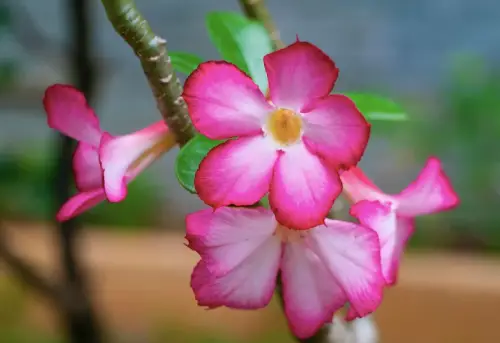 The thick succulent trunk, thin and soft leaves, and deep pink trumpeting flowers make Adenium an ideal bonsai plant.
The thick succulent trunk, thin and soft leaves, and deep pink trumpeting flowers make Adenium an ideal bonsai plant.
Adenium plant is solely hybridized for different flower colors such as orange and variegated etc.
It can be used as an outdoor ornamental plant in warmer areas ( extremely heat resistant) and as an indoor plant in colder areas.
The trunk of this plant is swollen as it stores water inside and indicates that there is sufficient water available and a thin trunk shows that more moisture is needed. Besides pink, Adenium can have orange, purple, red, white, and even yellow flowers.
The sap of Desert plants is harmful to human beings and pets.
Aeonium (Blushing Beauty)
- Height: Grows up to 24″ (60 cm) tall
- Blooming time: late spring
- Care: full sun, over-watering can be fatal for the plant, sandy loam well-draining soil
Aeonium Blushing Beauty is a succulent with pink flowers on long stems and a hybrid of two different aeoniums,
The leaves of Aeonium change shades from lime green to burgundy, depending upon different light exposures and temperature changes.
The plant develops branches and produces offsets.
The ornate pink or yellow flowers emerge from the center of the rosette, producing a long bloom stalk.
The Aeonium plant dies after blooming and the offsets keep growing and reproducing until they bloom.
Rose Pincushion cactus (Mammillaria Zeilmanniana)
- Height: 5″ tall and 3″ in diameter
- Blooming Time: May to August
- Care: Full sun, water adequately when the soil is dry, well-draining soil.
Mammillaria Zeilmanniana has many common names like Pincushion Cactus, Beehive cactus and Spinystar.
It is a soft-bodied, bright, green spherical cactus about 5 inches tall and 3 inches in diameter with 4 reddish central spines and clusters of 15- 18 soft, fuzzy white radial spines.
The flowers that appear in the early spring, are tiny, star-shaped, pale pink or purple in color and arranged in rings on the top of the plant, and are present mostly throughout the year.
For blooming, this plant needs perfect environmental conditions like
- water only when the soil completely dries up.
- Keep it in a warm place(not too hot).
- when the spring season arrives, stop watering for several weeks.
- In early spring, apply some cactus food, and the blooms will appear.
Crown of thorns (Euphorbia Milii)
- Height: 3 to 6 feet tall outdoors and 2 feet high indoors
- Blooming time: Spring, summer, fall, winter
- Care: Full sun to partial shade, water only when the soil is dry, ⅔ cactus potting soil and ⅓ perlite or coarse sand
A bushy, slow-growing succulent, Crown of thorns have sharp thorns on the dark brown stem with clusters of bright green leaves.
In the early spring to late summer, a Crown of Thorns plant blooms with colorful bracts in red, pink, and yellow around the small flowers.
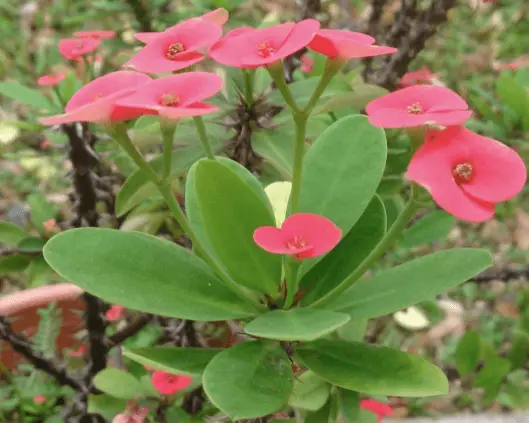
A Crown of Thorns plant blooms even indoors, throughout the year in favorable conditions.
Outdoors, can grow about 3-6 feet tall, and indoors, it attains a height of about 2 feet.
On exposure to sufficient sunlight, the plant gives abundant flowers.
Water your Crown of thorns only when the soil dries completely upto 50% and then water thoroughly and allow the soil to dry between waterings.
In winters, this succulent becomes semi-dormant,so water needs are much less.
Crown of Thorns prefers a lot of bright indirect sunlight.
Aloe Vera
- Height: 60–100 centimetres (24–39 inches) tall
- Blooming time: Late Winters or Early Spring
- Care: At least 6 hours of sunlight daily, water only when the soil is dry, well-draining potting mix
Aloe vera is a stemless or very short-stemmed succulent with pink flowers on long stems and has thick, greenish, fleshy and serrated leaves growing from the central stem in a rosette pattern.
A mature plant about 4 years of age blooms with a single stalk on which clusters of tubular flowers often red, pink, yellow and orange in color, develop.
Aloe Vera prefers at least 6 hours of sunlight everyday, but excess sunlight can sunburn the leaves.
Water aloe vera plants deeply, and intermittently and to avoid root rot, allow the soil to dry about 1 to 2 inches deep between waterings.
In winters, water your Aloe every three weeks or even less.
Use a well-draining potting mix containing perlite, chunks of bark, lava rocks or all three that is
especially made for cacti and succulents. Avoid using gardening soil.
Zebra plant (Haworthia)
- Height- 3 to 5 inches tall and wide; some species can be 20 inches tall
- Blooming time- In Summers
- Care- Full to partial sun, water only when the soil is dry, sandy, well-drained soil
A slow-growing succulent with pink flowers on long stems, the Zebra Haworthia blooms outdoors in the summer with small, tubular pink or white flowers on an inflorescence. However, it rarely blooms indoors.
Water your Zebra Plant only when the soil is dry. Use the “soak and dry” method, letting the soil dry out completely between waterings.
4-6 hours of sunlight in the morning is sufficient for the Zebra Plant.
Place it in a window with plenty of sun if it is kept indoor.
If more sunlight is provided, it turns deep red showing that the plant is stressed. The Zebra Plant turns white and dries in excessive sunlight.
Echeveria Peacockii
- Height: Grows 3″ to 1 feet (7 cm – 30 cm) and 15 cm. wide in diameter
- Blooming time: Spring and Summer
- Care: Full sun to partial shade, Water regularly but over watering can kill the plant, well- drained soil mixture.
Echeveria Peacockii is a hybrid succulent with pink flowers on long stems. These are easy to care for and have blue-gray leaves arranged in a rosette.
The bright pink, bell-shaped flowers are long-lasting (from weeks to even months) and bloom on a long stalk about 10 inches long emerging from the center of the rosette. Two or more bloom stalks grow from a single plant.
Water regularly, but avoid overwatering as it can kill the plant.
Avoid letting them sit in water in any condition and also never pour water directly on the leaves.
It prefers full to partial sun. Place it near a window getting at least 4 to 6 hours of bright morning light, but not the direct afternoon sun if kept indoors.
Well-draining, cactus mix, sandy soil, or regular potting soil with gravel and pumice is best for Echeveria Peacockii.
Echeveria Dusty rose
- Height: 3 to 5 inches tall and 8 inches in diameter
- Blooming time: Spring
- Care: Full to partial sun, water regularly, but avoid over-watering, porous soil with great drainage.
Echeveria Dusty Rose is a purple succulent with pink flowers on long stems. It is a fast-growing, rosette-forming succulent that offsets freely to form attractive clusters upto 20cm in diameters with powdery violet leaves that brighten with more sunlight.
Mature plants are 3 to 5 inches tall and 8 inches wide and bloom with the flowers that are bell shaped, coral pink in colour, emerging on long stalks.
Dusty roses prefer full sun, but protect them from harsh afternoon light to avoid sun burning the leaves.
Well-drained, porous soil is best for this plant. Water only when the soil is dry to protect the plant from rot and water should not be trapped between the leaves.
Also, provide your Dusty Rose with excellent airflow around the leaves and soil surface, and protect it from freezing temperatures in the winters.
Cobweb hens and chicks (Sempervivum Arachnoideum)
- Height: 1″ to 2″ tall and 4″ to 6″ wide
- Blooming Time: Summers
- Care: Full sun to partial shade, water every 7 to 10 days in Summers and once in a month or in 2- 3 weeks in winters, cactus mix or potting soil with coarse sand in 2:1
Sempervivum arachnoideum is a succulent ground cover with pink flowers.
Cobweb Hens and Chicks are low-growing, clump-forming succulents with green rosettes that are covered in white, hairy webbing. In full sun and in cold weather, the plant becomes purplish brown.
Like other sempervivums, these plants grow in clumps and spread by offsets and pups.
These are excellent ground covers and container plants as they are easy-going and adaptable in nature.
These are happy when grown outdoors with the right amount of sunlight and fresh air. When grown indoors, keep them outdoors during the warmer months to help them thrive.
Sempervivum arachnoideum ‘Cobweb Hens and Chicks’ like partial shade to full sun. In full sun, the plant turns purplish brown in color and in the shade, it remains green.
In Summers, water ‘Cobweb Hens and Chicks’ every 7-10 days. During the winter season, water it once in a month or in 2- 3 In weeks.
Use well draining soil to avoid root rot. Cactus potting mix with coarse sand in 2:1 is best for added drainage.
Echeveria Afterglow
- Height: about 1-2 ft. tall and wide (30-60 cm
- Blooming Time: Summers
- Care: Full sun, water thoroughly and allow the soil to dry between waterings, well draining soil with a mixture of cactus potting mix with some sand.
“Afterglow” plants have short stems that on maturity grow large rosettes about 12” to 16” inches.
With time, the stems can grow one to two feet tall.
The flowers are pinkish-lavender in color with bright edges and small orange-red flowers may appear below the foliage.
Afterglow prefers bright light and full sun throughout the day for brighter foliage.
“Purple Afterglow” grows best in warmer regions and plants can survive in temperatures as low as 35°F.
In colder areas, keep Echeveria ‘Afterglow’ indoors.
Water adequately and then let the soil dry before watering again.
Flowering Kalanchoe
- Height: 6 to 12 inches tall
- Blooming Time: Early Spring
- Care: Bright indirect sunlight, water only when the top 2 inches of soil is dry, well-drained and well-aerated potting soil with 60% peat moss and 40% perlite.
Calandivas are a new cultivar of the Kalanchoe blossfeldiana, known as Flowering Kalanchoe.
They bloom in a wide range of colors like red, orange, yellow, pink, and magenta.
These flowering Kalanchoes like bright, natural light, but avoid too much direct sun.
Your Kalanchoe will flower best in more light. In low light conditions, the foliage becomes spindly and the flower buds do not open.
Water the Kalanchoe well every two weeks, let it drain and then water again when dry.
Use 1/2 succulent & cactus mix and 1/2 potting soil for the best growth. All succulent & cactus mix can also be used with a little compost mixed in it.
Twin Spine Cactus (Mammillaria geminispina)
- Height: 6-12 in. (15-30 cm)
- Blooming Time: Late Spring/Early Summer, Mid Summer
- Care: Full Sun to Partial Shade, water regularly, do not overwater, well-draining soil.
Mammillaria geminispina is a cactus that forms a mound of clustered stems about 20 cm in height with white radial and longer brown central spines.
Flowers are 1.5cm in size, white striped with a deep pink colour that arise in late Spring to Mid Summer.
Twin spine cacti are drought resistant, need less water, so increase watering slowly in Summers, but avoid spraying the ball at noon to prevent sun burns. Limit watering in the rainy season and in winters.
Mammillaria geminispina needs loose and fertile, well-draining soil.
Aylostera Cactus
- Height: 4 cm. in height
- Blooming Time: In the Spring
- Care: Partial shade to full sun, water regularly in summers and sparingly in winters, well- draining soil.
Aylostera cactus is one of the most beautiful cacti that on maturity can be up to 4 cm (1.4″) tall and about 2.5 cm (1″) in diameter. The stem is green to dark green covered with small spines.
When the plant flowers, it produces pink flowers.
The best way of watering is the soak and dry method for this succulent. Water adequately and then let the soil dry before watering again.
Large, pink flowers on small spherical plants look stunning. It seeds freely to form fascinating, clumping groups.
Spider Cactus (Gymnocalycium Horstii)
- Height: stem can be about 12 inches (30 cm) tall and 24 inches( 60 cm) in diameter
- Blooming Time: Spring
- Care: Full Sun, water adequately and allow the soil to dry before watering again, well-draining soil.
Gymnocalycium Horstii is popularly known as the ‘Spider Cactus’. As the plant matures, it will reach up to 60 cm in diameter.
The spider cactus is globular shaped with brown stems. The plant produces flowers that are pink to purple in colour.
Gymnocalycium Horstii ‘Spider Cactus’ is a very fascinating plant.
It should not be allowed to sit on the water and avoid over- watering. The best way of watering is the soak and dry method for this succulent.
Well-draining soil is best for Spider cactus.
Cleistocactus Tarantula Cactus
- Height: Upto 3 feet in height
- Blooming Time: In Spring
- Care: Bright indirect sunlight, water only once in a month, cactus potting soil
Also known as the golden rat tail cactus, Cleistocactus Tarantula Cactus gives a striking display in hanging baskets. In addition to the spiny hairs, it also produces spun white hairs similar to cobwebs.
Tarantula cacti may grow as long as 3 feet in their native habitat, but will be smaller in homes.
In Spring, the plant blooms with pinkish-orange to light pink coloured flowers about 2.5 inches across with rayed petals.
Tarantulas break easily, so callous off the broken stems and plant them in spring to grow new plants.
They need watering about once a month in the growing season.
Use a cactus potting soil or a mixture of 2 parts sand and 1 part loam in a pot with plenty of drainage holes.
Fertilize in spring and summer once per month with a balanced fertilizer. Avoid watering and feeding as the plant goes dormant in winters.
The tarantula cactus plant will thrive for years with the least care on your part.
Kalanchoe Katapifa Tarantula
- Height: 1 foot tall and 8 inches in width
- Blooming Time: Spring and Autumn
- Care: lots of sunlight, infrequent watering, and well-draining succulent soil
Kalanchoe Tarantula’ is a perennial succulent with pink flowers. It is a bushy green succulent with irregular, spidery leaves and produces small bunches of long-lasting, vibrant pink or red flowers in Spring and Autumn.
Easy to care for, these Kalanchoes are grown as houseplants or succulent garden plants.
These soft succulents cannot survive a hard frost. To prevent rot, they need lots of sunlight, well-draining soil, and infrequent watering.
Use well-draining cactus and succulent soil with 50% to 70% mineral grit such as coarse sand, pumice, or perlite.
Water adequately enough for water to run out the drainage holes, then wait for the soil to dry completely before watering again.
